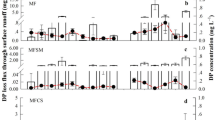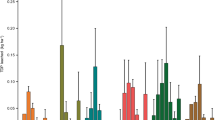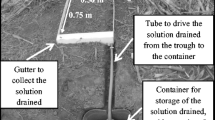Abstract
Phosphorus losses in runoff from sugarcane fields can contribute to non-point source pollution of surface and subsurface waters. The objective of this study was to evaluate the effects of three different management practices on P losses in surface runoff and subsurface leaching from sugarcane (Saccharum officinarum L.) fields. Field experiments with treatments including conventional burning (CB), compost application with burning (COMB), and remaining green cane trash blanketing (GCTB) treatments were carried out to assess these management practice effects on P losses from sugarcane fields. In the CB treatment, sugarcane residue was burned after harvest. The COMB treatment consisted of compost applied at “off bar” with sugarcane residue burned immediately after harvest. Compost was applied in the amount of 13.4 Mg ha−1 annually, 8 weeks before planting. In the GCTB treatment, sugarcane residue was raked off from the row tops and remained in the wheel furrow after harvest. Surface runoff was collected with automatic refrigerated samplers, and subsurface leachate was collected with pan lysimeters over a period of 3 years. Measured concentrations of total P (TP), dissolved reactive P (DRP), and particulate P (PP) in surface runoff from the COMB treatment were significantly higher than concentrations from the CB and GCTB treatments. The mean losses of P (TP and DRP) after burning (postharvest, years 2 and 3) were significantly greater than the no-burn treatment (preharvest, year 1) in the CB, COMB, and CB/COMB/GCTB combined options. Additionally, the mean losses of total suspended solid and total combustible solids in residue burning were, on average, 2.7 and 2.2 times higher than the no-burn practices, respectively (preharvest and GCTB treatment). Annual P losses from surface runoff in the third year of study were 12.90%, 6.86%, and 10.23% of applied P in CB, COMB, and GCTB treatments, respectively. However, the percent of annual DRP losses from applied P in COMB and GCTB treatments was similar magnitude, and their values were less than 50% compared to the value from CB treatment. In the leaching study, percent of monthly mean TP and DRP losses in the COMB and GCTB treatments were greatly reduced. Based on these results, the COMB and GCTB procedures were equally recommended as sugarcane management practices that improve water quality in both surface runoff and subsurface leachate.




Similar content being viewed by others
Abbreviations
- CB:
-
Conventional burning
- COMB:
-
Compost application with burning
- GCTB:
-
Green cane trash blanketing
- DRP:
-
Dissolved reactive phosphorus
- PP:
-
Particulate phosphorus
- TP:
-
Total phosphorus
- TCS:
-
Total combustible solids
- TSS:
-
Total suspended solids
References
Arbex, M. A., Martins, L. C., de Oliveira, R. C., Pereira, L. A. A., Arbex, F. F., Cancado, J. E. D., et al. (2007). Air pollution from biomass burning and asthma hospital admissions in a sugar cane plantation area in Brazil. Journal of Epidemiology and Community Health, 61, 395–400.
Avalos, J. M. M., Fouz, P. S., Vázquez, E. V., González, A. P., & Bertol, I. (2009). Crop residue effects on organic carbon, nitrogen, and phosphorus concentrations and loads in runoff water. Communications in Soil Science and Plant Analysis, 40, 200–213.
Bruggeman, A. C., & Mostaghimi, S. (1993). Sludge application effects on runoff, infiltration, and water quality. Water Research Bulletin, 29, 15–25.
Bundy, L. G., & Sturgul, S. J. (2001). A phosphorus budget for Wisconsin cropland. Journal of Soil and Water Conservation, 56, 243–249.
Bundy, L. G., Andraski, T. W., & Powell, J. M. (2001). Management practice effects on phosphorous losses in runoff in corn production systems. Journal of Environmental Quality, 30, 1822–1828.
Cancado, J. E. D. (2006). The impact of sugar cane-burning emissions on the respiratory system of children and elderly. Environmental Health Perspectives, 114, 725–729.
Cassel, E. A., Dorioz, J. M., Kort, R. L., Hoffman, J. P., Meals, D. W., Kirschtel, D., et al. (1998). Modeling phosphorous dynamics in ecosystems: Mass balance and dynamic simulation approaches. Journal of Environmental Quality, 27, 293–298.
Ceddia, M. B., Anjos, L. H. C., Lima, E., Ravelli Neto, A., & Silva, L. A. (1999). Sugarcane harvesting systems and changes on physical properties of a yellow podzolic soil in Espirito Santo, Brazil. Pesquisa Agropecuaria Brasileira, 34, 1467–1473.
Cermak, J. D., Gilley, J. E., Eghball, B., & Wienhold, B. J. (2004). Leaching and sorption of nitrogen and phosphorus by crop residue. American Society of Agricultural and Biological Engineers, 47, 113–118.
Clay, J. (2004). World agriculture and the environment: 7. Sugarcane. Washington: Island.
Correll, D. L. (1998). The role of phosphorus in the eutrophication of receiving waters: A review. Journal of Environmental Quality, 28, 261–266.
Daniel, T. C., Sharpley, A. N., & Lemunyon, J. L. (1998). Agricultural phosphorus and eutrophication: A symposium overview. Journal of Environmental Quality, 27, 251–257.
Duguy, B., Rovira, P., & Vallejo, R. (2007). Land-use history and fire effects on soil fertility in eastern Spain. European Journal of Soil Science, 58, 83–91.
Edwards, W. M., & Owens, L. B. (1991). Large storm effects on total soil erosion. Journal of Soil and Water Conservation, 46, 75–77.
Gee, G. W., & Bauder, J. W. (1986). Particle-size analysis. In A. Klute (Ed.), Methods of soil analysis. Part 1—physical and mineralogical methods (pp. 383–411). Madison: ASA and SSSA.
Gérard-Marchant, P., Walter, M. T., & Steenhuis, T. S. (2005). Simple models for phosphorus loss from manure during rainfall. Journal of Environmental Quality, 34, 872–876.
Gilley, J. E., & Kottwitz, E. R. (1994). Maximum surface storage provided by crop residue. Journal of Irrigation and Drainage Engineering, 120, 440–449.
Gilley, J. E., & Risse, L. M. (2000). Runoff and soil loss as affected by the application of manure. Transactions of the American Society of Agricultural Engineers, 43, 1583–1588.
Graham, M. H., Haynes, R. J., & Meyer, J. H. (2002). Soil organic matter content and quality: effects of fertilizer applications, burning and trash retention on a long-term sugarcane experiment in South Africa. Soil Biology and Biochemistry, 34, 93–102.
Grande, J. D., Karthikeyan, K. G., Miller, P. S., & Powell, J. M. (2005). Corn residue level and manure application timing effects on phosphorus losses in runoff. Journal of Environmental Quality, 34, 1620–1631.
Kuo, S. (1986). Phosphorus. In D. L. Sparks (Ed.), Methods of soil analysis. Part 3—chemical methods (pp. 869–919). Madison: ASA and SSSA.
Li, Y., & Ghodrati, M. (1997). Preferential transport of solute through soil columns containing constructed macropores. Soil Science Society of America Journal, 61, 1308–1317.
Liao, N., & Marten, S. (2000). Determination of total phosphorus by flow injection analysis colorimetry. Milwaukee: Zellweger Analytics, Lachat Instruments Division.
Mathers, N. J., Nash, D. M., & Gangaiya, P. (2007). Nitrogen and phosphorus exports from high rainfall zone cropping in Australia: Issues and opportunities for research. Journal of Environmental Quality, 36, 1551–1562.
McDowell, R., & Sharpley, A. (2002). Phosphorus transport in overland flow in response to position of manure application. Journal of Environmental Quality, 31, 217–227.
Mitchell, R. D. J., Thorburn, P. J., & Larsen, P. (2000). Quantifying the loss of nutrients from the immediate area when sugarcane residues are burnt. Proceedings of the Australian Society of Sugar Cane Technologists, 22, 206–211.
Peterson, A. E., Speth, P. E., Corey, R. B., Wright, T. W., & Schlecht, P. L. (1994). Effect of 12 years of liquid digested sludge application on the soil phosphorus level. In C. E. Clapp (Ed.), Sewage sludge: Land utilization and the environment (pp. 237–247). Madison: SSSA.
Pionke, H. B., Gburek, W. J., Schnabel, R. R., Sharpley, A. N., & Elwinger, G. F. (1999). Seasonal flow, nutrient concentrations and loading patterns in stream flow draining an agricultural hill-land watershed. Journal of Hydrology, 220, 62–73.
Pote, D. H., Daniel, T. C., Nichols, D. J., Sharpley, A. N., Moore, P. A., Miller, D. M., et al. (1999). Relationship between phosphorus levels in three ultisols and phosphorus concentration in runoff. Journal of Environmental Quality, 28, 170–175.
Poudel, D. D., & Jeong, C. Y. (2009). Manual composite sampling in edge-of-field surface runoff for assessing nonpoint source pollution from agricultural lands and residential areas. Journal of Soil and Water Conservation, 64, 324–335.
Quinton, J. N., Catt, J. A., & Hess, T. M. (2001). The selective removal of phosphorus from soil: Is event size important? Journal of Environmental Quality, 30, 538–545.
Robertson, F. A., & Thorburn, P. J. (2007). Management of sugarcane harvest residues: Consequences for soil carbon and nitrogen. Australian Journal of Soil Research, 45, 13–23.
Rostagno, C. M., & Sosebee, R. E. (2001). Biosolids application in the Chihuahuan Desert: Effects on runoff water quality. Journal of Environmental Quality, 30, 160–170.
SAS Institute Inc. (2002). JMP statistics and graphics guide, version 5. Cary: SAS Institute.
Schreiber, J. D. (1999). Nutrient leaching from corn residues under simulated rainfall. Journal of Environmental Quality, 28, 1864–1870.
Schreiber, J. D., & McDowell, L. L. (1984). Leaching of nitrogen, phosphorus, and organic carbon from wheat straw residues: I. Rainfall intensity. Journal of Environmental Quality, 14, 251–256.
Sharpley, A. N. (1995). Dependence of runoff phosphorus on extractable soil phosphorus. Journal of Environmental Quality, 24, 920–926.
Sharpley, A. N., Chapra, S. C., Wedepohl, R., Sims, J. T., Daniel, T. C., & Reddy, K. R. (1994). Managing agricultural phosphorus for protection of surface waters: Issues and options. Journal of Environmental Quality, 23, 437–451.
Sharpley, A. N., Kleinman, P. J. A., Heathwaite, A. L., Gburek, W. J., Folmar, G. J., & Schmidt, J. P. (2008). Phosphorous loss from an agricultural watershed as a function of storm size. Journal of Environmental Quality, 37, 362–368.
Simard, R. R., Beauchemin, S., & Haygarth, P. M. (2000). Potential for preferential pathways of phosphorus transport. Journal of Environmental Quality, 29, 97–105.
Soil Survey Staff (2009). Natural Resources Conservation Service, United States Department of Agriculture. Soil Survey Geographic (SSURGO) Database. Available online at http://soildatamart.nrcs.usda.gov.
Somenahally, A., Weindorf, D. C., Darilek, L., Muir, J. P., Wittie, R., & Thompson, C. (2008). Spatial variability of soil test phosphorous in manure amended dairy soils of north central Texas. Journal of Soil and Water Conservation, 64, 89–97.
Thorburn, P. J., Horan, H. L., & Biggs, J. S. (2004). Nitrogen management following crop residue retention in sugarcane production. Super Soil 2004: 3rd Australian New Zealand Soils Conference, 5–9 December 2004. University of Sydney, Australia
Udawatta, R. P., Motavalli, P. P., Garrett, H. E., & Krstansky, J. J. (2006). Nitrogen losses in runoff from three adjacent agricultural watersheds with claypan soils. Agriculture, Ecosystems & Environment, 117, 39–48.
Udeigwe, T. K., Wang, J. J., Viator, H. P., & Gaston, L. (2009). Surface water quality as affected by sugarcane residue management techniques. Water Air and Soil Pollution, 208, 119–128. doi:10.1007/s11270-009-0153-2.
Vadas, P. A., Kleinman, P. J. A., & Sharpley, A. N. (2004). A simple method to predict dissolved phosphorus in runoff from surface-applied manures. Journal of Environmental Quality, 33, 749–756.
Vanni, M. J., Renwick, W. H., Headworth, J. L., Auch, J. D., & Schaus, M. H. (2001). Dissolved and particulate nutrient flux from three adjacent agricultural watersheds: A 5-year study. Biogeochemistry, 54, 85–114.
Viator, R. P., Garrison, D. D., Dufrene, E. O., Jr., Tew, T. L., & Richard, E. P., Jr. (2005). Planting method and timing effects on sugarcane yield. Crop Management. doi:10.1094/CM-2005-0621-02-RS. Online.
Viator, R. P., Johnson, R. M., Grimm, C. C., & Richard, E. P., Jr. (2006). Allelopathic, autotoxic, and hormetic effects of postharvest sugarcane residue. Agronomy Journal 98, 1526–1531.
Zeimen, M. B., Janssen, K. A., Sweeney, D. W., Pierzynski, G. M., Mankin, K. R., Devlin, D. L., et al. (2006). Combining management practices to reduce sediment, nutrients, and herbicides in runoff. Journal of Soil and Water Conservation, 61, 258–267.
Acknowledgments
This research was supported by the Louisiana Department of Environmental Quality (LDEQ). The authors thank Dr. Durga Poudel for his invaluable technical assistance and the anonymous reviewers for helpful comments on the manuscript.
Author information
Authors and Affiliations
Corresponding author
Additional information
Lora L. Goodeaux is deceased.
Rights and permissions
About this article
Cite this article
Jeong, C.Y., Weindorf, D.C., DeRamus, A. et al. Surface and Subsurface Phosphorus Losses from Sugarcane Fields with Different Management Practices. Water Air Soil Pollut 217, 649–661 (2011). https://doi.org/10.1007/s11270-010-0617-4
Received:
Accepted:
Published:
Issue Date:
DOI: https://doi.org/10.1007/s11270-010-0617-4




